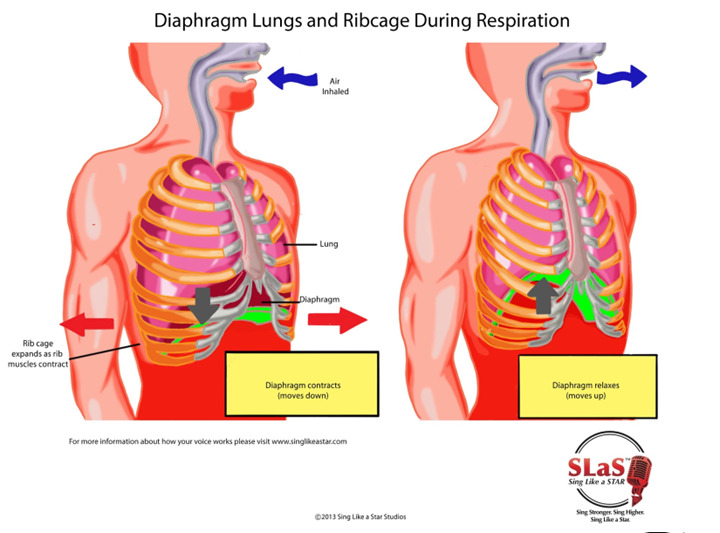Have you ever heard someone say sing from your diaphragm or put your hand on your diaphragm?
When we ask new students what they have been told about breathing, they almost always mention singing from the diaphragm. This phrase is bandied about by choir directors and voice teachers alike, usually without much explanation about what “singing from the diaphragm” actually entails.
First of all, it is impossible to sing from your diaphragm; the diaphragm is incapable of creating sound. The basic voiced sound is created by the opening and closing of the vocal folds. This basic sound is subsequently filtered in the vocal tract.
You might have been told that we create “support” with the diaphragm. That is not exactly true either. The diaphragm has no volition or independent ability to create support or sound. It simply goes down and up automatically when we breathe in and out.

At rest, before inhalation, it looks like a parachute or upside-down bowl. When a breath is taken, the ribs expand and the diaphragm lowers and flattens, drawing the lungs downward and decreasing the air pressure in the thorax so air is drawn in.
We don’t have to think about this process, just as we don’t have to think about our heart beating.
In singing, however, we exert conscious control (indirectly) over the diaphragm by first relaxing the abdominals and expanding the ribcage for a 360-degree expansion during inhalation, and then delaying the ascent of the diaphragm to its original dome shape during the extended exhalation phase of breathing by engaging appoggio, or resistance to the collapse of the ribcage and abdominal wall.
If breath pressure is not excessive, an even and consistent flow of air is sent to the vocal folds (not too much and not too little).
So, although we do not have direct control over the diaphragm and cannot see or feel it, we control it indirectly with breath management and appoggio.
And that is what “singing from the diaphragm” really is!
THE ROLE OF THE DIAPHRAGM IN RESPIRATION
As we inhale, the external intercostal muscles contract, expanding the ribcage. The diaphragm contracts and lowers, creating more volume (space) inside the thorax. Because of the increase in volume in the thorax, air pressure lowers, and the air is drawn in; the greater the volume of a cavity, the lower the resulting air pressure becomes.
The diaphragm works like the piston in your car; when it goes down, it draws the air in due to the difference in atmospheric air pressure. When it goes up, the air is pushed out of the body.

EXERCISE: STEAM HEAT
Here is an exercise to improve breath support for singing- the Steam Heat exercise.
First, expand 360 degrees to the front, sides, and back as you inhale. Ribs, tummy, and back all inflate as you inhale the breath. Then, exhale on a loud hiss (SSSSSSSSS). You will notice the muscles on the side of the body (transversus abdominis and lateral oblique muscles) engage on the exhale. These are the muscles of support, otherwise known as appoggio. These are the muscles that should activate when you sing.
Breath support or appoggio is the foundation of good singing. With active respiration, we affect or control both inhalation and exhalation. During inhalation for singing, the abdominal muscles should relax; there will be an expansion around the middle of the torso, including the epigastrium, waistline, bottom ribs, and lower back. As the diaphragm lowers, it displaces the internal viscera slightly, causing slight outward expansion of the epigastrium (the area of the abdomen between the navel and the sternum) and torso. Focus mainly on the sideways or lateral expansion of the lower ribcage during inhalation.
Simply expand the lower ribcage outward while relaxing the abdominal muscles during inhalation; everything else will follow. When the ribs open, a vacuum is created due to differences in air pressure and air naturally flows in. The expansion of the lower ribcage, epigastrium, waistline, abdomen, and back is known as the 360-Degree Singer’s Breath.

